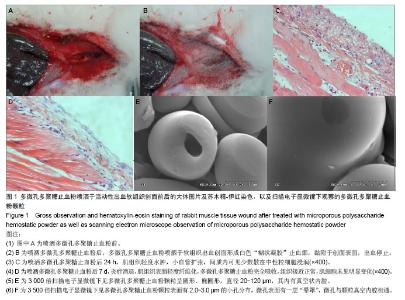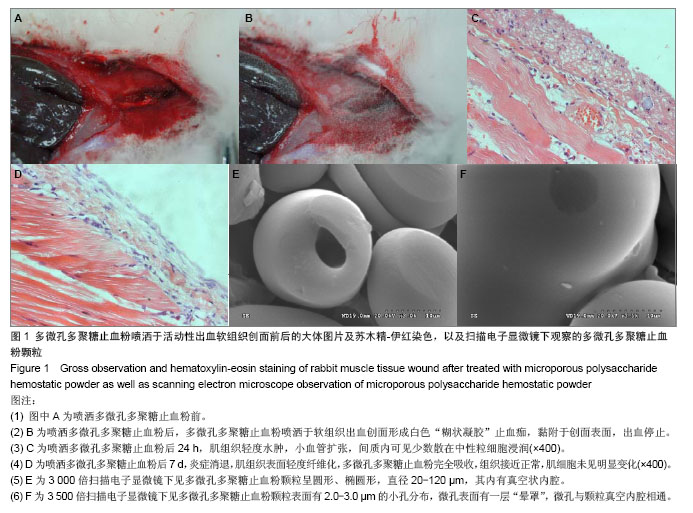| [1]Murat FJ,Ereth MH,Dong Y,et al.Evaluation of microporous polysaccharide hemospheres as a novel hemostatic agents in the porcine model.J Urol. 2004;172(3):1119-1122.[2]Tan SR,Tope WD.Effectiveness of microporous polysaccharide hemospheres for achieving hemostasis in mohs micrographic surgery.Dermatol Surg.2004; 30(6): 908-914.[3]沈晨阳,张小明,李伟,等.术中止血材料——AristaTM在血管外科中的应用[J].中华普通外科杂志,2006,21(7):532-533.[4]杜宝堂.利用植物淀粉经交叉乳化制备术中止血材料的方法:中国,201110073208.2 [P].2013-07-17.[5]中华人民共和国科学技术部.关于善待实验动物的指导性意见. 2006-09-30.[6]李学军,孙园园.不同生物止血材料研究进展及复合型止血材料的临床应用[J].中国组织工程研究与临床康复,2011,15(51): 9671-9674.[7]牛雯,刘毅,张博,等.可吸收性多聚糖止血材料PerClotR对颅骨愈合的影响[J].中国组织工程研究与临床康复,2010,14(34) : 6351-6354.[8]牛雯,刘毅,李志超,等.淀粉型可吸收多聚糖止血粉预防大鼠术后肠粘连[J].中国组织工程研究与临床康复,2009,13(12): 2287-2290.[9]祝去山,吴海山,李晓华,等.微孔多聚糖止血球在人工髋关节置换术中的应用[J].第三军医大学学报,2007,29(24):2379-2380.[10]Ereth MS,Ibonga J,Oliver W,et al.Microporous polysaccharide hemospheres do not inhibit bone healing compared to bonewax or microfibrillar collagen. Othopedics. 2008;31(3): 222.[11]Uitte de Willige S,Miedzak M,Carter AM,et al.Oteolytic and genetic variation of the alpha-2-antiplasmin C-terminus in myocardial infarction. Blood. 2011;117(24):6694-6701.[12]Ishisaki A,Matsuno H.Novel ideas of gene therapy for atherosclerosis: modulation of cellular signal transduction of TGF-beta family.Curr Pharm Des.2006;12(7):877-886.[13]Humphreys MR,Castle EP,Andrews PE,et al. Microporous polysaccharide hemospheres for management of laparoscopic trocar injury to the spleen. The Am J Surg. 2008;195(1):99-103.[14]Bjorses K,Hllst J.Topical haemostatics in renal trauma anevaluation of four different substances in an experimental setting.J Trauma. 2009;66(3):602-611.[15]Stephan SJ,Tholpady SS,Gross B,et al.Injectable tissue-engineered bone repair of a rat calvarial defect. Laryngoscope.2010;120(5):895-910.[16]Humphreys MR,Castle EP,Andrews PE,et al.Microporous polysaccharide hemospheres for management of laparoscopi crocar injury to the spleen. Am J Surg.2008;195(1):99-103.[17]Emmez H,Tonge M,Tokgoz N,et al.Radiological and histopathological comparison of microporous polysaccharide hemospheres and oxidized regenerated cellulose in the rabbit brain: a study of efficacy and safety. 2010;20(4):485-491.[18]Ereth MH,Dong Y,Schrader LM,et al.Microporous Polysaccharide Hemospheres do not enhance abdominal infection in a rat model compared with gelatin matrix.Surg Infect(Larchmt).2009;10(3):273-276.[19]李钒,田丰,刘长军,等.急救止血材料的研究进展[J].材料导报, 2013,27(3):70-73.[20]Barnard J, Millner R. A review of topical hemostatic agents for use in cardiac surgery.Ann Thorac Surg.2009;88(4): 1377-1383.[21]张少锋,洪加源.医用生物可吸收止血材料的研究现状与临床应用[J].中国组织工程研究,2012,16(21):3941-3944.[22]Tschan CA,Nie M,Schwandt E,et al.Safety and efficacy of microporous polysaccharide hemospheres in neurosurgery. Neurosurgery.2011;69(1 suppl operative): 49-62.[23]王白石,杨红岩,晏晓青,等.微孔多聚糖材料用于体表创腔止血效果评价[J].医疗卫生装备,2012,33(4):80-81.[24]Ereth MH,Henderson JL,Schrader LM,et al.Efficacy of microporous polysaccharide hemospheres on liver punch biopsies porcine model. Anesthesiology.2003;99(A):153.[25]Murat FJ,Ereth MH,Dong Y,et al.Evaluation of microporous polysaccharide hemospheres as a novel hemostatic agent in open partial nephrectomy: favorable experimental results in the porcine model.J Urol.2004;172(3):1119-1122.[26]余雪松,黄赤兵,张银甫,等.多孔止血淀粉的制备及其生物相容性[J].中国组织工程研究与临床康复,2008,12(32):6270-6274.[27]郑朝旭,吴荣耀,余俊峰,等.微孔多聚糖止血球在腹腔镜脾切除术中的应用[J].中华普通外科学文献:电子版,2008,2(6):465-468.[28]谢斌,唐春,金世龙,等.MPH对肝脏切除术后残肝断面止血效果的临床观察[J].重庆医科大学学报,2009,34(7):955-958.[29]黄永安,张晖,张宝国,等.神经外科手术中新型止血材料AristaTM的应用探讨[J].中华神经医学杂志,2009,8(8):857-858,861.[30]罗东方,陈跃平,高辉,等.微孔多聚糖止血球在全髋关节置换中的应用[J].中国组织工程研究,2012,16(26):4792-4795. |

